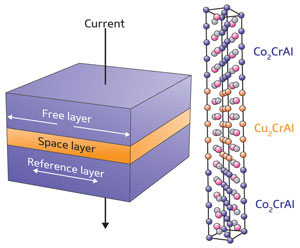| Posted: March 17, 2010 |
A tailored material combination may boost the sensitivity of future disk-drive read heads |
|
(Nanowerk News) To increase the storage density of disk drives beyond their present-day capabilities, scientists need to realize ‘giant magnetoresistive’ (GMR) spin valves for use in their read heads. A combination of the ‘Heusler’ alloys Co2CrZ (Z = Si or Al) and Cu2CrAl are shaping up as attractive material components for such devices, owing to work from Viloane Ko and co-workers from the Data Storage Institute of A*STAR, Singapore ("The band structure-matched and highly spin-polarized Co2CrZ/Cu2CrAl Heusler alloys interface").
|
|
Information in hard disk drives is stored using the orientation of the ‘spin’ of electrons associated with magnetic atoms on the disk and retrieved by read heads that are sensitive to their orientation.
|
 |
| Fig. 1: A schematic diagram of a CPP GMR spin valve (left), a potential component in future hard disk drive read heads, consisting of lattice- and electronic band structure-matched chromium-based alloys (right). (Image: Viloane Ko)
|
|
In GMR spin valve-based read heads of the current-perpendicular-to-plane (CPP) type, a nonmagnetic spacer layer is sandwiched between two ferromagnetic electrodes (Fig. 1). The reference layer’s spin is ‘pinned’ to one direction, whereas the ‘free’ layer’s spin orients according to the direction of the spins it probes on the disk. If the spins in the two layers are parallel to each other, spin-polarized electrons flow easily through the device; if they are antiparallel, however, the resistance is high—hence the term GMR—yielding a sensitive probe of the binary information stored on the disk.
|
|
In principle, Heusler alloys are ideal materials for GMR read heads because their spin polarization is close to 100%, notes Ko, but their GMR properties have been lower than expected. “One of the major obstacles is the lack of suitable spacer materials,” says Ko. Attempts by other researchers using transition-metal spacer layers, such as copper and silver, resulted in poor matching of the electronic band structure between the electrode and spacer materials—essentially a poor ‘alignment of the roads’ via which electrons can travel.
|
|
Using density functional theory-based calculations, however, Ko and his co-workers showed that Cu2CrAl has potential as a good spacer layer material when sandwiched between either Co2CrSi or Co2CrAl. These material combinations provide three specific benefits that could yield a high GMR effect in spin valves, according to Ko: they have excellently matched electronic band structures; high interfacial spin polarization, which is important because interface states are known to degrade polarization; and small crystalline lattice mismatch.
|
|
Ko and his team are pursuing an experimental realization of a GMR spin valve made from the reported Heusler alloy combination but, as Ko points out, compositional control of the proposed Heusler alloy spacer is a challenge that remains to be overcome.
|
|
The A*STAR affiliated authors in this highlight are from the Data Storage Institute.
|

